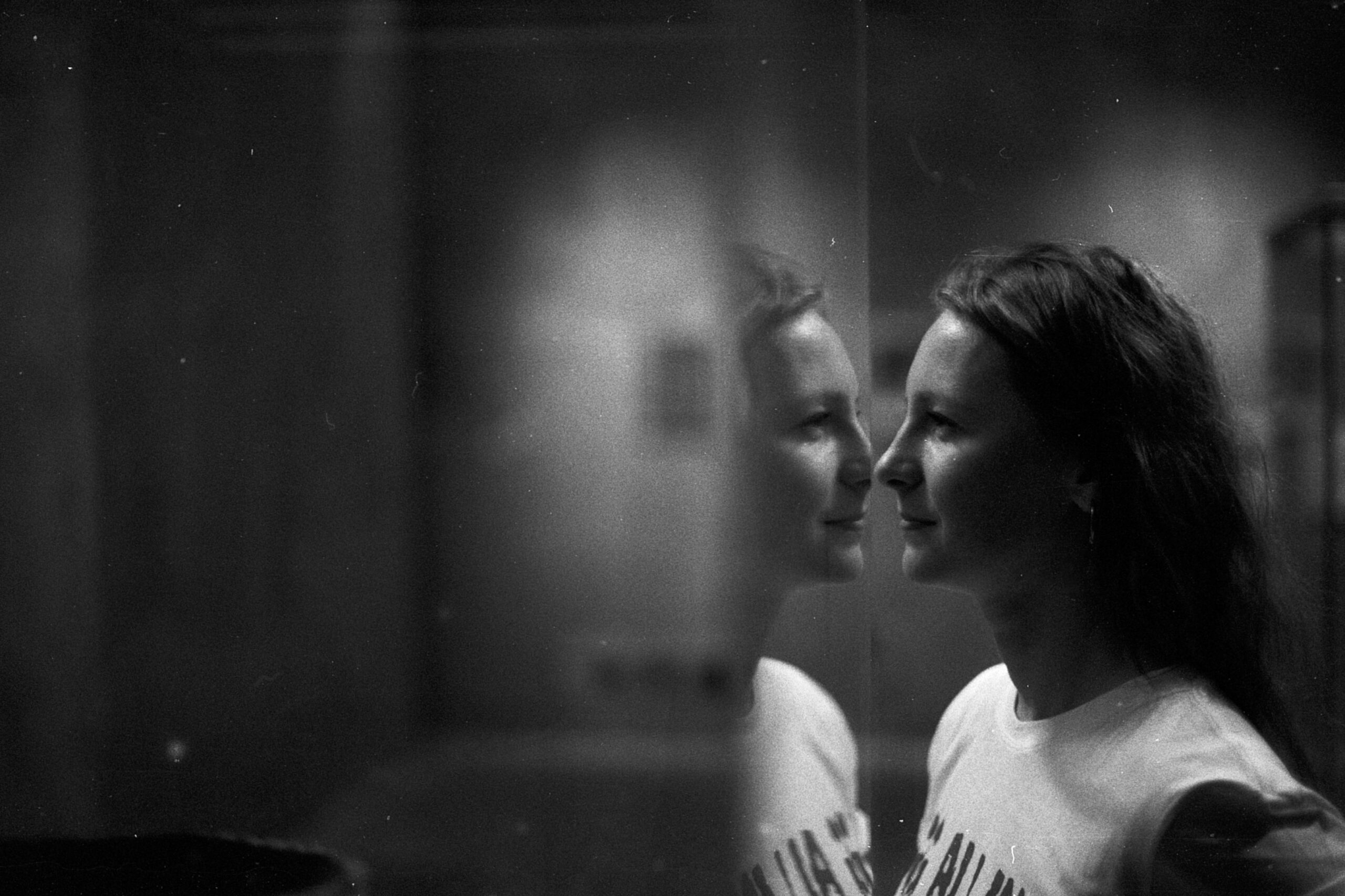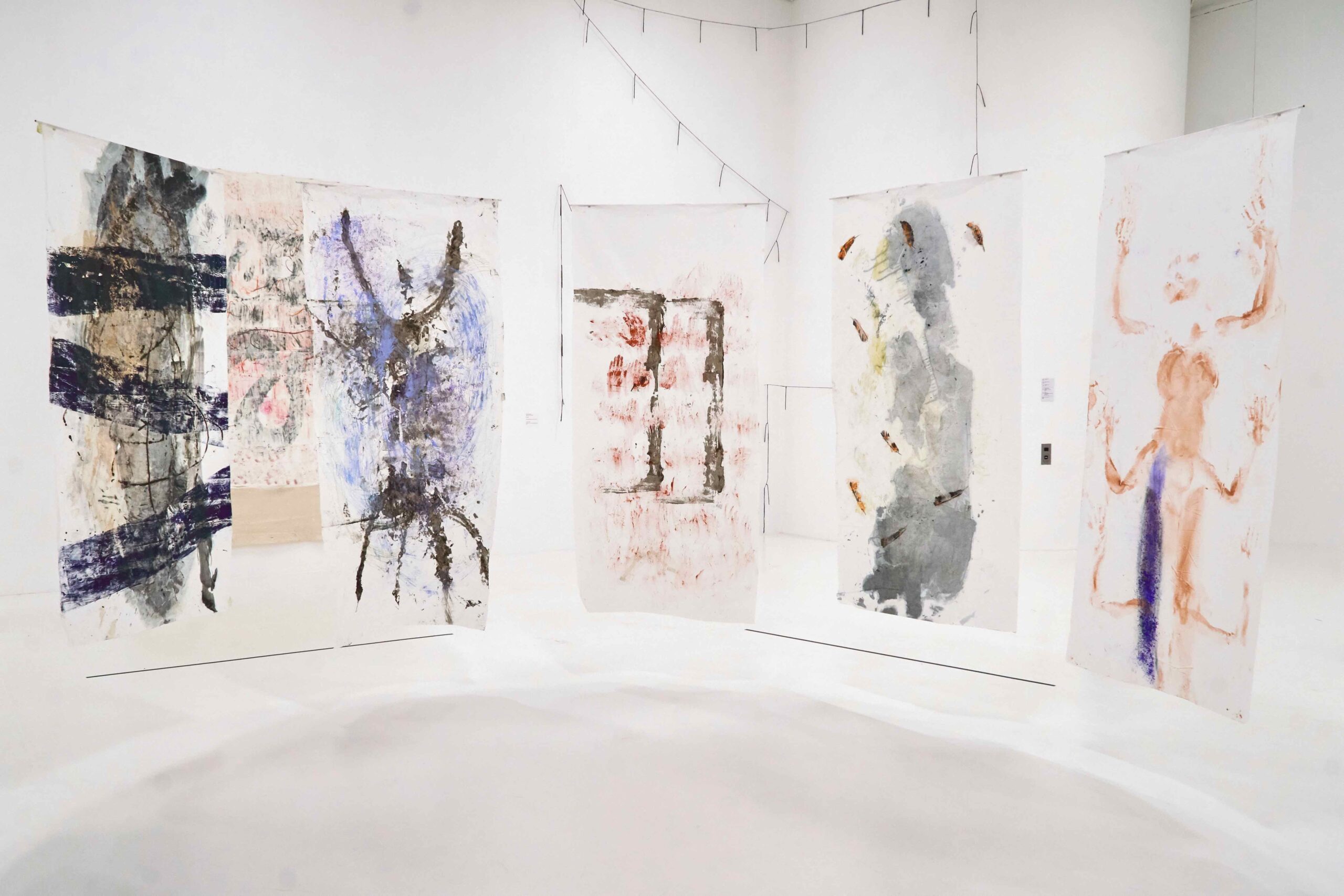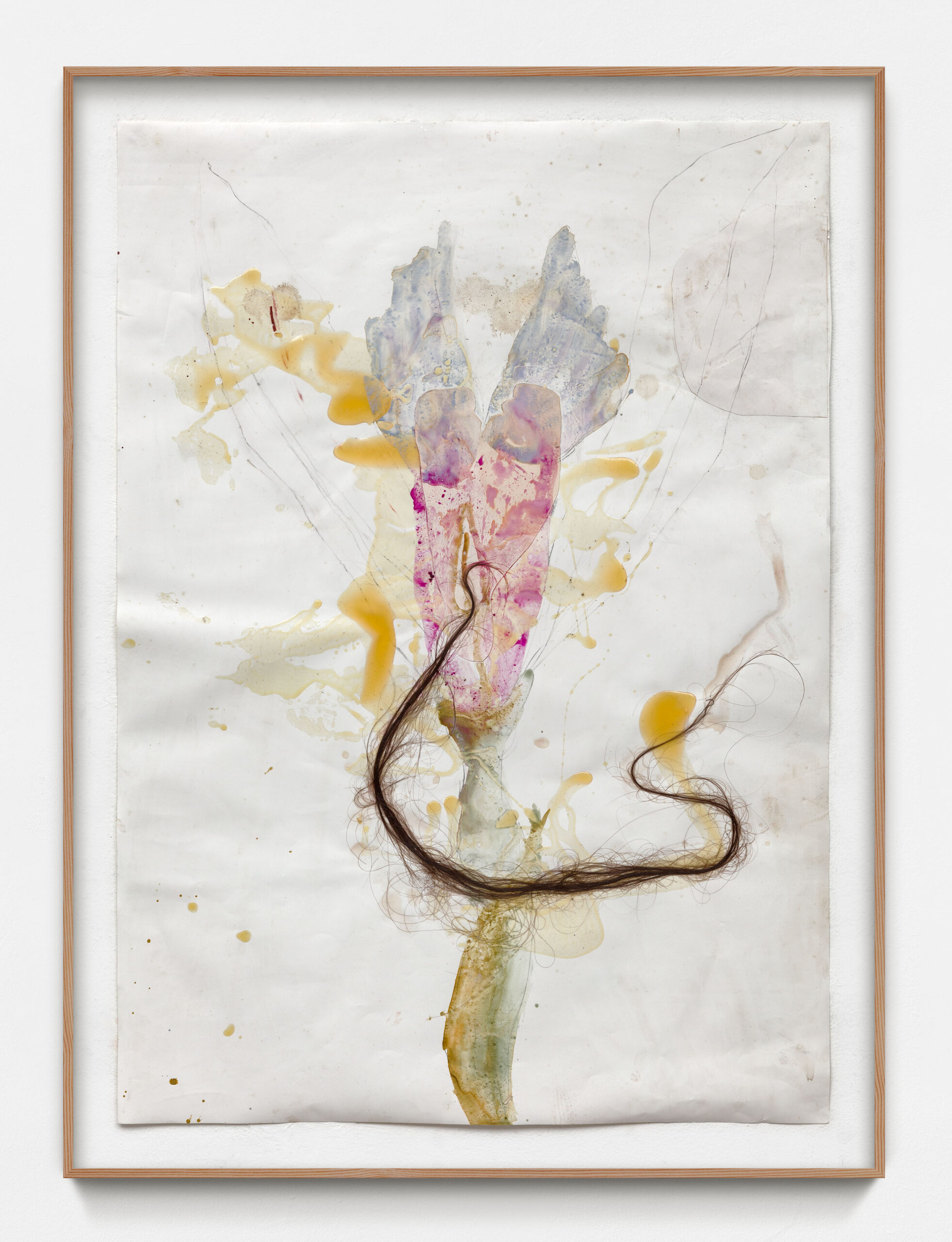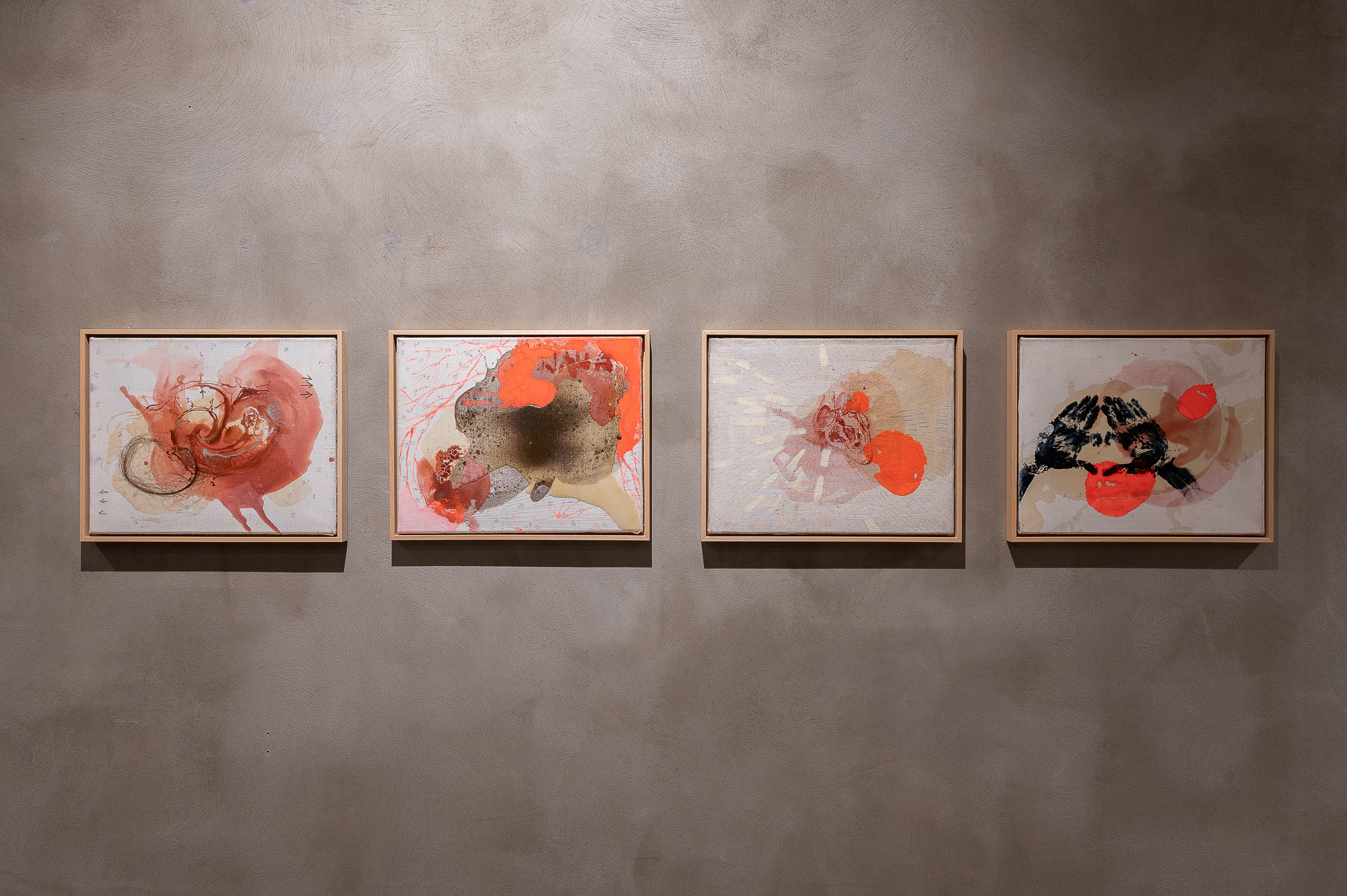
“Question Them”
Interview with artist Jana Zatvarnická
Jana Zatvarnická spent two months in Budapest participating in the Budapest Gallery’s residency programme, during which she pursued knowledge, skills and stories that were revealed through the study of Hungarian and Slovakian witchcraft history. She concluded her residency with an open studio presentation on May 27th at the Budapest Gallery’s Klauzál Square artist studio. The interview was recorded in the studio a few weeks before her departure, while the project was still in progress.
You’re here for a 2-month residency. During this, you’ve been doing research regarding witchcraft and witch hunts in Hungary and Slovakia. What topics generally attract you and how did you end up with this very specific focus?
Generally, I am interested in environmental, ecological and socio-political issues, addressing post-human theories by using references from archives, history and mythology which I transfer into my artworks. In this particular research, I am using narratives from witch-hunt trials. In addition to witchcraft, my research includes the study of medicinal plants, their healing properties, ethnobotany, mythological stories and their use in rituals and folk medicine, as well as the relationship between humans and plants and how it was manifested during the period of witch-hunting in Hungary and Slovakia. The history of plants has always been influenced, modified and interrupted by current political situations. This was happening mostly in relation to the expanding capitalist class and its exploitation and domination over nature and human bodies. In the territory in which my research takes place, the majority of people who had knowledge about the use of medicinal plants and their healing properties were women healers, who were then persecuted and punished during witch-hunt processes and with them, the knowledge about plants got oppressed as well. That’s why I began to study the testimonies of the witch-hunt trials, searching for some specific information regarding plants, so, that’s where the connection with witch-hunts comes from. These topics always attracted me, so the residency at Budapest Gallery was a great opportunity to take time and dive deeper into this topic. The study of medicinal plants is basically part of my daily life, I love to collect them and learn about their healing properties.
Can you describe what methods you use for the preparation of a certain project or a certain focus in your artistic practice? What institutions you have been in connection with within in the last few years and which are you cooperating with right now?
The way I work is usually a very organic process and of course, it depends on what theoretical and physical material I have at my disposal at that moment to work with in my artistic practice. Approximately about a year ago, I started systematic research about medicinal plants which I integrated into my artistic practice. I focus on different aspects of (mostly) medicinal/healing plants which I researched, for example, at Herzogin Anna Amalia Bibliothek, Goethes Haus, Goethe-Schiller Archiv at Klassik Stiftung in Weimar (DE), the National Herbarium Archive of UWI in St. Augustine (TT) and East Slovak Museum in Košice (SK), as well as other botanical gardens etc…
For example, when I went through Goethe’s collection of medicinal plants in Weimar, I was interested in migratory and ethnobotanical processes of foreign plants in the context of colonial histories of European countries and green imperialism. Plants for me are something that we all can relate to; they are like collective fluid bodies and they have a lot of stories to tell.
In the case of the herbs and plants you examine and work with, in what proportion do you access them via institutions or via nature itself, or any other ways?
My first source is, of course, nature, but when learning about their histories and stories from the past, I meet people, visit archives and study old herbariums, codices and manuscripts, where I can find some relevant information and visual interpretations of the plants.
You’ve worked with two institutions in Budapest. How has the research been going here?
Well, actually, I am working more with individuals, but yes, few of them work or worked at institutions like the Museum of Ethnography or the Semmelweis Museum. This research is ongoing, as I have found that the topics I focus on are very relevant today. The mechanisms of accusations, misogyny and female body politics are processes that are still repeating and they haven’t disappeared from our society even after witch-hunt trials were banned.
How do you get your connections?
It depends on the place, the topic and the language skills, who are willing to meet and share their knowledge. But I get them mostly by recommendations and of course, in this case, friends, art practitioners, researchers and the Budapest Gallery gave me some useful tips as well.

Research has grown quite close to artistic practices in general. What do you think about that? Do you see research as the base of your artistic practice?
The way I work is usually a very organic process and of course, it depends on what I have at my disposal at that moment, such as the theoretical and physical materials that I can work with in my artistic practice and what topic I am interested in at the moment. Some topics require more research and information, some don’t. I would say most of the time, it goes hand in hand.
Based on this, your research process develops very much parallel to the actual process of creating your artwork.
Yes, as I explained, it is an organic process and I do not have an exact methodology. Also, many aspects of the topics I am interested in are based on my own personal experience.
Painting for me is the way of direct translation onto the canvas of the knowledge I gained through the research process. Without the need to transfer what I experience or what I am interested in, I probably wouldn’t do art. If I’m interested in a specific topic, the research process starts. What I find in the archives, is like a source of inspiration for me. From my work, which is very process-based and in a way abstract, not only the visual narratives are interesting but also the use of materials, forms, colours and symbols that I find important. Of course, the approach is critical in a way because I’m trying to find some relevant information or objects in the archives that could help us redefine and relearn the existing knowledge of the archives.
What stories have unfolded throughout your work so far? Can you tell me some details of your work process here in Budapest?
What unfolded were truly horrible stories of violence and types of punishment inflicted on persecuted women during the witch-hunt trials that I was focusing on during the research. Stories about institutionalized prejudices against women, general hatred of women, inequality, mechanisation of the body, Christian misogyny and many more aspects I examined during the process of this particular research have a strong connection to the Central-Eastern European region and I am very happy that many contemporary artists are also addressing these issues.
The topic of witchcraft obviously involves lots of spiritual/ritual motifs. Is this rather a personal need or is there an inherent part of this topic that is independent of your own personality?
I guess it’s quite natural that when you are interested in something, it’s your personal need, isn’t it?

You mostly work in two dimensions. Are you trying to push the boundaries of conventional painting by using materials on such a wide range?
I don’t think I am trying to push the boundaries of something, as from a certain point it becomes a very intuitive process. Intuition is an inseparable part of the creative process and the use of materials mostly depends on their meaning or what is available at the location where I am working.
What would you say is an ideal environment to display your works in?
That really depends on the topic and the work, it’s hard to generalize. But for this particular research, I could imagine a space that itself serves as a reference to my content.
In your art, I see somewhat of a documentational approach as you transfer and apply materials very directly onto the canvas or whatever the base of your painting is. I sense an ambition to somewhat illustrate a specific detail of the “big picture”, by which I mean your whole research.
I wouldn’t use the word illustration; I would say I work with concrete information. It’s important for me not to get illustrative in this matter because in my artwork I like to leave space for the viewers for them to step in and co-create, feel and sense the artwork, so they can relate to the picture in their own way.
When an artwork is finished and is on its own, without me standing next to it and explaining what is painted there, it has its own life, its own energy, its own story. What if all the stories we know about artworks were fictional? How would we read them then?
The gesture of direct transfer of material – hair, wax, plants, etc. – can also be seen as an attempt to wash away the line between art and nature.
By direct transfer, I mean the process of transferring the topic or information I am interested in directly onto the canvas. I enjoy working with natural materials because you can find them everywhere and so you are not bound to a certain place. In that sense, I have the freedom to work almost anywhere. Pure materials have their own power to tell a lot of stories, it’s almost metaphysical and it has its own archaeology.

Creating your own visionary story and your own pictures based on textual or oral information seems a great opportunity to change common or canonized approaches and perspectives. But what does ‘changing’ or thinking ‘differently’ exactly mean to you?
In the big-scale paintings, for example, I depict stereotypes of women (so-called witches), how they’ve been perceived, how they have been represented by society and how stereotypes have been created as an impact of Christian misogyny. For example, in one painting, there is a woman with half of her body as a horse having an orgy with a monster, while plants are growing out of her body. After a dialogue with a few researchers, I was explained, that there is no visual information on the witch-hunt trials here, as there is in Germany, England, Italy, etc. because they were destroyed. So, I decided to create my own visionary stories and imagine a sort of herbarium of plants of those persecuted women.
I think it’s about deconstructing and reconstructing stories. So, in the end, it concerns all of us, we all become part of these stories, creating new narratives based on already existing data in the archives. The change might be in the questioning of existing histories that we have learned at school and home, that have been presented to us as the ultimate truth.
So, it’s about offering an alternative to existing and canonized narratives.
I like to look into history, search for why certain stories have been born and then question them; who created them and what kind of impact they still have today. This is what interests me.
In your current work, an eco-feminist approach is quite prominent. In my experience, eco-feminist practices are shifting towards collective/collaborative acts, performative or cross-disciplinary mediums. Do you have any collaborative aspects of your work process?
In my artistic practice, I participate in many interdisciplinary projects in collaboration with other artists, researchers, healers, speleologists, environmentalists, botanists, musicians, etc. by organizing exhibitions, lectures, talks and performances. I enjoy all kinds of activities that offer me the possibility to exchange, discuss and discover something new.
Offering alternatives to existing paradigms is a very distinct characteristic of the current contemporary art scene. Do you yourself experience such offerings in your own environment?
Yes, I do, for example, building communities and entanglements between artists, as well as creating safe spaces for all creatures and humans. I think a good alternative is to think about how to survive here on this Earth together (inspired by D. Harraway), by not competing, but trying to coexist in more loving ways so we don’t completely destroy ourselves and the Earth. There is still a lot more work to be done.
Proofreader: Martha Kicsiny
Cover photo: Portrait of Jana Zatvarnická (Photo: Dominika Čupková)
